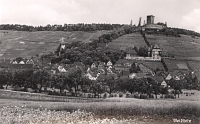Beilstein 1914-1915
1914
The outbreak of war in July takes Purrmann by surprise in Beilstein. In Paris, he loses his studio, his apartment, and many paintings (including works by Renoir, Cézanne, Seurat, Picasso, Rousseau, and Matisse). In this period, he is often in Stuttgart, where he cultivates relationships with the painter Bernhard Pankok and the art dealer Zinser. Mathilde withdraws from painting to care for the children.
Purrmann is called up for conscription at the end of December, but is released from military service in view of his disability. Purrmann suffers from Thomsen’s disease, a rare congenital nerve disorder that limits his freedom of movement and reaction speed. It causes him periodic falls and minor injuries.
Purrmann begins to commit greater energies to graphic art, in particular drypoint, and continues to do so into the nineteen-twenties. He draws landscapes, nudes, and portraits, some of which were oriented to paintings and works of Matisse created at the same time.
He is mentioned as a representative example in Wilhelm Hausenstein’s book “Die bildende Kunst der Gegenwart” (Munich, 1914).
Purrmann is called up for conscription at the end of December, but is released from military service in view of his disability. Purrmann suffers from Thomsen’s disease, a rare congenital nerve disorder that limits his freedom of movement and reaction speed. It causes him periodic falls and minor injuries.
Purrmann begins to commit greater energies to graphic art, in particular drypoint, and continues to do so into the nineteen-twenties. He draws landscapes, nudes, and portraits, some of which were oriented to paintings and works of Matisse created at the same time.
He is mentioned as a representative example in Wilhelm Hausenstein’s book “Die bildende Kunst der Gegenwart” (Munich, 1914).
1915
Purrmann continues to reside in Beilstein. In May, Weisgerber falls at Ypres, and his death grieves Purrmann deeply. Purrmann is deeply troubled, though he seeks to remain objective: “We Germans are ourselves not free from blame ...” (Roland 1996, p. 212).
In Stuttgart, he discovers and acquires the painting “Venus at Her Toilet” by Johann Liss, a painter of the German Baroque. Purrmann spends the summer in Munich, where he copies the “Massacre of the Innocents” by Peter Paul Rubens in the Alte Pinakothek. He meets with the art historian Heinz Braune (1880–1957) and makes an etching of him, as well as a portrait of Braune’s wife. Braune is later to become not only a museum director in Breslau and Stuttgart, but also, quite early in his career, one of the most significant of Purrmann’s collectors.
Purrmann participates almost every year from 1915 on in the exhibitions of the Free Secession in Berlin, at times participating in the exhibitions of the Berlin Secession as well. In September of 1915, he begins looking for an apartment and studio in Berlin.
In Stuttgart, he discovers and acquires the painting “Venus at Her Toilet” by Johann Liss, a painter of the German Baroque. Purrmann spends the summer in Munich, where he copies the “Massacre of the Innocents” by Peter Paul Rubens in the Alte Pinakothek. He meets with the art historian Heinz Braune (1880–1957) and makes an etching of him, as well as a portrait of Braune’s wife. Braune is later to become not only a museum director in Breslau and Stuttgart, but also, quite early in his career, one of the most significant of Purrmann’s collectors.
Purrmann participates almost every year from 1915 on in the exhibitions of the Free Secession in Berlin, at times participating in the exhibitions of the Berlin Secession as well. In September of 1915, he begins looking for an apartment and studio in Berlin.






